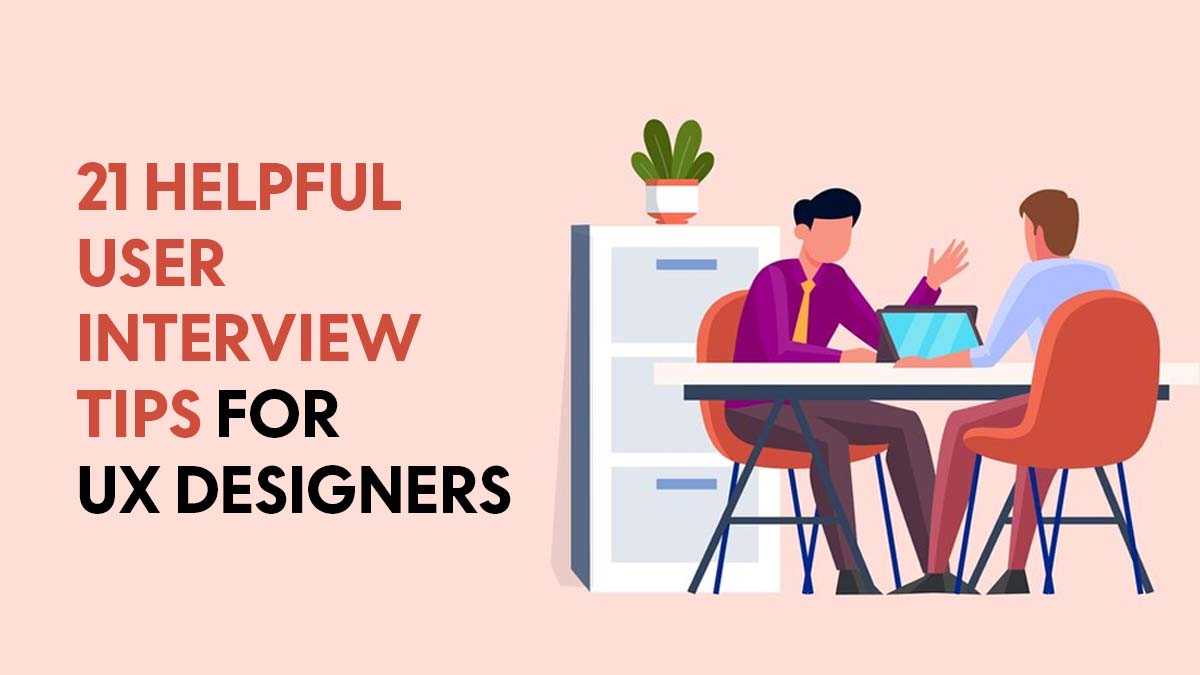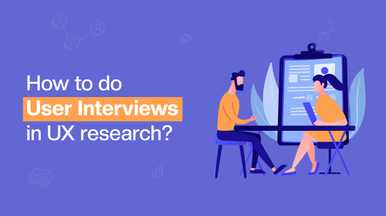Welcome to our blog, where we’ll unveil a treasure trove of user interview tips to empower you in your design journey.
Imagine this: a blank canvas stretched before you, brimming with infinite possibilities. But where do you begin?
How do you identify the individuals who will embrace your product eagerly?
User interviews are a vital tool in the world of user experience design. They involve 30- to 60-minute long conversations between designers or UX researchers and users, where designers ask questions and listen attentively to gather valuable insights.
These interviews help uncover users’ thoughts, needs, preferences, and expectations, allowing designers to create products that truly meet their users’ requirements.
Whether you’re a seasoned researcher or just starting out, these user interview tips will elevate your skills and help you design with empathy and user-centricity.
Get ready to unlock the secrets of effective user interviews and take your designs to new heights!
21 User Interview Tips for UX Designers
Conducting effective user interviews can unlock valuable insights that inform and shape the design process.
However, interviews that yield meaningful results require a strategic approach and a set of well-honed skills.
Here are a few tips to keep in mind when conducting user interviews.
Whether you’re a seasoned professional or just starting out, these tips will act as an interview guide and equip you with the knowledge and techniques necessary to conduct insightful interviews that drive your design decisions.
#1) Think from the end.
When planning user interviews, it’s important to think from the end. Start by defining your goal and what you want to achieve through the interviews.
What insights or information do you need to gather to make informed decisions?
By considering the desired outcomes upfront, you can structure your interviews to focus on those specific areas, ensuring that you gather the necessary data to reach your goals.
This helps you stay focused, ask relevant questions, and obtain actionable insights that directly contribute to your design process.
#2) Over-recruit for interview
This means reaching out to more people than you actually need for the interviews. Why? Because not everyone you contact will be available or willing to participate.
This ensures a diverse range of perspectives and reduces the risk of the data being skewed by a small sample size. So, be proactive and reach out to more potential participants than you initially anticipated.
#3) Adopt a funnel approach.
When structuring the user interviews, it is effective to use a funnel approach, starting with broad and general questions and gradually moving towards more specific topics.
This approach allows participants to warm up, gradually delve into deeper discussions, and provide thoughtful responses.
This creates a comfortable environment for participants to share their experiences and insights. As the interview progresses, you can gradually narrow down the focus and explore specific details.
#4) Strategically select user participants.
To conduct effective qualitative interviews, it is crucial to strategically select your research participants.
The goal is to deliberately select those who represent a diverse range of experiences and perspectives related to the research topic.
By purposefully sampling, you can ensure that your findings do not overlook key concepts or narrow down theories prematurely.
This allows for a comprehensive exploration of the phenomenon being researched, leading to more meaningful and insightful interview outcomes.
#5) Avoid problematic queries.
Problematic queries are those that are leading, biased, or confusing to participants.
These types of questions can result in inaccurate or unreliable responses, which can impact the quality of your research findings. To ensure effective interviews, strive for neutrality in your questioning.
Be clear and concise, and avoid assumptions or leading phrases.
Goal is to ask open-ended and neutral questions, you create a comfortable environment for participants to express their thoughts and provide honest feedback.
#6) Schedule interviews in sequential order for users
When planning user interview, it is beneficial to schedule them sequentially rather than on the same day or with multiple interviewers in parallel.
Conducting interviews one by one with intervals in between allows researchers to update their interview questions based on new insights gained from previous interviews.
This approach provides an opportunity to analyze and incorporate any fresh information or perspectives into subsequent sessions.
It enhances the effectiveness of your interviews, increases the depth of your understanding, and helps you gather richer data from participants.
#7) Use a cheat sheet.
This cheat sheet acts as a handy reference, helping you navigate tricky situations on the spot.
When interviewees haven’t provided sufficient information, you can dig deeper by using phrases like “Tell me more about that” or “Can you provide an example?”
The cheat sheet serves as a reminder for non-leading phrases, ensuring that your questions remain unbiased and open-ended.
Even experienced researchers utilize cheat sheets, as they lead to more fruitful discussions and better research outcomes.
#8) Review the research goals.
Before conducting user interviews, take a moment to review your research goals and notes. Clarify the decisions or design choices you need to make based on the research findings.
This step helps you align your interview questions and prompts with the specific information required to inform those decisions.
This ensures that your interviews are purposeful, targeted and provide the insights you need to move forward confidently.
#9) Time management tips.
It’s essential to allocate sufficient time for each interview session and ensure that you don’t run out of time before covering all the necessary topics.
Plan your interview structure and questions with time constraints in mind.
Be mindful of the pace of the conversation, allowing enough time for participants to provide comprehensive answers. Also, consider scheduling buffer time between interviews user to avoid overlapping or rushing discussions.
#10) Find a way to bond with the participants.
Establishing trust and creating a comfortable environment is a good way to help participants feel at ease and encourage open and honest communication.
Use friendly and welcoming gestures, listen attentively, and show genuine interest in their experiences.
This helps foster a positive atmosphere where participants feel valued, leading to more meaningful and insightful conversations.
#11) Employ probing techniques.
Establishing trust and creating a comfortable environment is a good way to help participants feel at ease and encourage open and honest communication. Use friendly and welcoming gestures, listen attentively, and show genuine interest in their experiences.
This helps foster a positive atmosphere where participants feel valued, leading to more meaningful and insightful conversations.
#12) Empathy is the goal.
Empathy is a vital quality for a UX designer conducting user interviews. Put yourself in the user’s shoes to truly understand their perspective. Approach the interviews with genuine curiosity and a desire to empathize with their experiences.
This allows you to connect on a deeper level, helping you grasp their emotions, frustrations, and aspirations. By understanding their perspective, you can design products that address their real needs and provide meaningful solutions.
#13) Ask for assistance to take notes.
Having a second person helps in various ways. They can take notes, observe non-verbal cues, and provide a different perspective during the interview.
Also, having a partner allows you to focus more on actively listening and engaging with the participant, ensuring that you don’t miss important details.
Collaborating with a colleague enhances the quality of the interview and provides a more holistic understanding of the user’s experiences.
14) Avoid judging things or educating your participants in user interview.
Maintain an unbiased and non-judgmental stance throughout the conversation. A good way is to avoid imposing your own opinions, assumptions, or solutions.
Focus on genuinely understanding the participant’s perspective, allowing them to express their thoughts and experiences freely.
By creating a safe and judgment-free space, you encourage participants to share openly and provide authentic insights that may not have surfaced otherwise.
#15) Use the critical incident method when interviewing.
The critical incident method is a technique that helps gather specific and detailed information and question about users’ experiences.
Instead of asking general questions, prompt participants to recall specific incidents or moments that stood out to them. Encourage them to provide vivid descriptions of what happened, how they felt, and why it was significant.
This method allows for deeper exploration and provides rich, context-specific insights.
#16) Interviewer need to clarify in real time.
While conducting user interviews, it’s essential for the interviewer to clarify and seek further explanation for interviewee responses in real time.
If something is unclear or requires more context, don’t hesitate to ask follow-up questions for clarification.
By seeking real-time clarification, you ensure that you fully understand the participant’s perspective and avoid misinterpreting their responses.
This active clarification helps gather accurate and nuanced data, leading to more informed design decisions.
#17) Embrace silence and pauses.
During user interviews, it’s important to leave pauses after asking questions. Silence during interviews can be uncomfortable, but it shouldn’t be feared.
Embrace moments of silence, as they can allow participants to reflect and gather their thoughts. It provides an opportunity for participants to express themselves more thoughtfully and reveal deeper insights.
Instead of rushing to fill the silence, be patient and give the interviewee space to process their response.
By embracing silence, you create a relaxed environment that encourages participants to share more meaningful and considered information.
#18) Promote a bias-free environment and encourage valid responses.
Communicate to participants that there is no bias and no right or wrong answer. Create a safe and non-threatening environment where they feel comfortable sharing their honest opinions and experiences.
A good way is to assure participants that their responses are valued and respected, you foster an open and authentic dialogue. This encourages participants to share their genuine thoughts, leading to more insightful and valuable information.
#19) Be ready for unforeseen responses.
When conducting user interviews, be prepared to hear things that may challenge your assumptions or preferences.
Stay open-minded and receptive to feedback, even if it goes against your initial expectations.
Remember, the purpose of the interview is to understand the user’s perspective, not to seek validation for your ideas.
Embrace the opportunity to learn and adapt based on the feedback received, as it can lead to valuable insights and improve the overall user experience.
#20) Never look for approval from the participants in user interviews.
It’s important to prevent participants from telling you what they think you want to hear. Instead, encourage them to provide honest and unbiased feedback.
Emphasize that their candid opinions are essential for improving the product or service.
Avoid leading questions or prompts that may influence their responses. By fostering an environment of genuine feedback, you ensure that the insights gathered are authentic and reliable.
#21) Conduct a quick review to condense and summarize.
After conducting user interviews, take the time to run a short review process on interview data. Reflect on the key insights and themes that emerged from the interviews.
Condense and summarize the information to capture the most important findings. This review helps you consolidate the data and identify patterns or common threads across interviews in research platform.
Conclusion
In conclusion, user research and UX user interviews are a powerful tool for understanding users and designing impactful experiences.
By incorporating these pro-user interview tips into your UX design toolkit, you’ll be able to conduct user interviews that not only uncover valuable user insights but also empower you to make informed design decisions that truly cater to your audience’s needs.
For further insights on UX user interviews, feel free to visit our blog and explore more in-depth information on the topic.
FAQs
#1) What are some of the key user interview questions?
Key user interview questions should be open-ended and focused on understanding the user’s needs, behaviors, and preferences.
- Can you tell us about your experience with a product or service?
- How do you currently perform a specific task?
- What challenges have you faced while using a product or service?
- Can you walk us through a recent experience you had with a product or service?
#2) What are the 3 key steps to prepare for a user interview?
- Defining the research objectives and goals
- Identifying the target audience and recruiting participants
- Preparing an interview guide with open-ended questions to gather comprehensive insights
#3) How do you end a user interview?
End a user interview by thanking the participant for their time and insights. Ask if they have any final thoughts or feedback before concluding the session.
#4) What are the three types of user interviews?
The three types of user interviews are exploratory interviews, evaluative interviews, and comparative interviews. Exploratory interviews are used to understand user needs and behaviors.
Evaluative interviews are used to test the usability of a product or service. Comparative interviews are used to compare and contrast user experiences with different products or services.
Each type of interview serves a different purpose and can provide valuable insights to inform the design and development of a product or service.
#5) What is the difference between user testing and user interviews?
User testing involves observing users interacting with a product or service to identify usability issues, while user interviews are focused on understanding user needs, behaviors, and preferences through open-ended questions.
#6) What are common mistakes in user interviews?
Some of the common mistakes in user interviews are:
- Asking leading or biased questions
- Interrupt participants during the interview.
- Failing to build rapport with participants
- Use of jargon or technical terms that are not easily understood by participants.
- Not following up with participants after the interview
#7) How long should be user interviews?
45 minutes is a reasonable length for user interviews when taking into account the disinterested participants’ short attention spans. However, if the discussion is going really well, it’s a good idea to find out if they’d be prepared to talk for longer than the given time.
It’s important to establish the length and objectives of the interview up front and to thank them for their time. Starting with open-ended inquiries aids in clearing up misconceptions and eliciting new suggestions.
Additionally, establishing a delay between interviews allows for required pauses, contemplation, and note-taking. Setting these priorities guarantees more fruitful and informative user interviews.
#8) What not to do in user interviews
- Avoid asking questions that nudge participants in a certain direction.
- Don’t dominate or interject during conversations; instead, give everyone the chance to completely express themselves.
- Don’t assume anything about the viewpoints, experiences, or goals of the participants.
- Refrain from using jargon or other technical terms; instead, use plain, basic English.
- Maintain neutrality and objectivity; do not impose personal beliefs or prejudices.
- Don’t hurry the interview; give participants enough time to express their thoughts.
- During the interview, stay focused on the participant and avoid multitasking or other distractions.
- Never discount or reject the opinions of participants; instead, listen attentively and with sincere curiosity.
- Avoid asking questions that imply the answers or sway people’s opinions.
- Don’t use closed-ended questions that limit participants to simple “yes” or “no” answers.
#9) How does user interviews pay?
User interviews often do not include any kind of direct payment. As a substitute, non-monetary incentives are often given to participants as a way of showing their gratitude for their time and work.
Gift cards, free samples of goods, exclusive access to new features, and charitable contributions are just a few examples of these inducements.
Without granting direct compensation, the objective is to provide participants something of value and acknowledge their involvement to the study process.
#10) Why do user interviews fail?
- poorly defined aims and unclear objectives
- Posing biased or deceptive queries
- Poor or insufficient participant recruitment
- Inability of interviewer and participant to establish rapport and trust
- Inadequate preparation and a lack of follow-up with participants
- Ineffective interviewing methods, such as dominating or interrupting the discussion Confirmation bias, which causes information to be interpreted in a biased manner
- Ineffective synthesis and analysis of interview data






